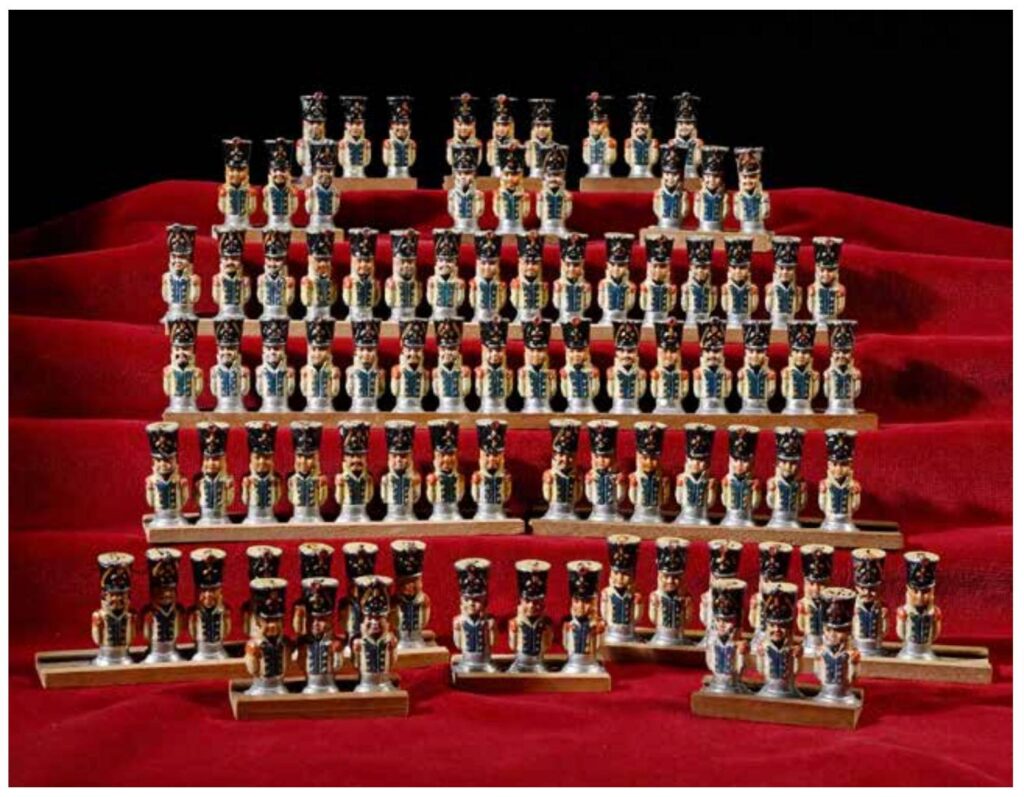
An historically very important set of lead soldiers came up for auction in Paris earlier this year. Reputedly made for Napoleon’s son, the King of Rome, in the early 1800s, this was one of the most complete collections of such figures to be offered for public sale.
Rather more like chess pieces than what we would today regard as a toy soldier, these 88 4cm tall figures represented a number of Napoleon’s infantry regiments. Cast in lead, they are painted in the uniform of Napoleon’s legions. In this case, they have white jackets, with blue lapels and gold buttons, with details such as rank painted on the top of each shako. The shakos are decorated with fleurde-lys.
Presented on their fifteen original wooden strips, nine each carrying three soldiers, four for eight soldiers and two for sixteen soldiers, the set was offered in its original wooden box with remnants of an annotation in pen “… to Mr. Dubois Aymé in Grenoble”. Jean-Marie Joseph Aimé Dubois, known as Dubois-Aymé lived from 1779-1846, and the figures have remained in the family since then.
A letter in the family from Dubois Aymé, addressed to Edouard Devilliers (his friend from the École Polytechnique) in 1818 reads:
« J’ai reçu les petits bons hommes de plomb, mon cher Edouard, mais je voudrais que tu demandas à Magincel la petite note qui devait les accompagner et qui indique quels sont les grades qui répondent aux lettres placées sur les shakos. »
“I have received the little lead figures, my dear Edouard, but I would like you to ask Magincel for the little note that was to accompany them and which indicates which ranks correspond to the letters placed on the shakos.”
The group, or the “game” as it was referred to in the Dubois Aymé family, was said to have come from the King of Rome who had a similar game representing the 21st and 22nd Light Infantry Regiments, that had been given to him for his 1st birthday on March 20, 1812. Napoleon Francis Joseph Charles, known as Napoleon II, was the son of Napoleon I and Marie Louise, Archduchess of Austria. He was created King of Rome when he was born.
Jean Marie Joseph Aimé Dubois was a student of the École Polytechnique (1796). Appointed engineer of Bridges and Roads, he found himself at the age of less than 20 in the scientific commission set up by Monge and Berthollet, within the French Army’s expedition to Egypt.
On his return from Egypt, he entered the Customs administration, in Marseille. He entered politics and was a Deputy for Ile-et-Vilaine in 1831, and then for Isère. He is known for his support for the abolition of the death penalty and for arguing against the prosecution of the Bonaparte family .
Christian Blondieau in his “Little soldiers. The collector’s guide”, (Petits soldats. Le guide du collectionneur, Képi rouge Paris, 1996, p.565) notes other examples of similar models of “Kriegspiel”, allowing children to reconstruct an imaginary battlefield. Other references to these toys can be found at the Napoleon.org website: see for example, Karine Huguenaud, “Lead Soldiers of the King of Rome”, and “Toys of Prince 1770-1870”, catalogue of the exhibition at the castles of Malmaison and Bois Préau, RMN, 2001, fig 40. p.114.
Estimated at 6,000-8,000 Euros (roughly the same equivalent in dollars) excluding commission charges, the final hammer price is not shown on the auctioneer’s website.
However, a number of similar (albeit much smaller and less fine condition) groups have gone under the hammer in other auctions. For example, a group of 8, with its original strip base, was sold in June 2021 by De Baecque et Associés. Estimated at 600-800 Euros, the hammer came down at 2,296 Euros including commission charges. While in March of this year a dozen similar figures (including 2
officers) in much poorer condition was sold for 2,080 Euros. Keep your eyes peeled!
